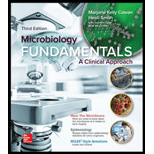
Concept explainers
Introduction:
Infections occur due to an abnormal condition of body that disrupts important physical and physiological function of body. Disease is caused by improper diet, lack of exercise, various infectious agents that are present in nature, toxic substances, genetic disorders, and depression, stress that play role in illness and disturbs normal functioning of body.
Answer to Problem 1Q
Correct answer:
Clostridium difficile is a most common cause of acute diarrhea and is associated with CDC due to its antibiotic resistance characteristics. Therefore, option (b) is correct.
Option (b) is given as “Clostridium difficile”.
Explanation of Solution
Justify reason for the correct statement:
There are some drug resistant pathogens are present in large intestine such as C.difficile. An antibiotic treatment may disrupt large intestine as antibiotic disturbs normal biota. Due to these bacteria produces two enterotoxins such as toxin A and B causes necrosis in intestinal walls and results in diarrhea as well as Clostridium difficile colitis. It is condition occurs in which inflammation occurs in colon.
Hence, option (b) is correct.
Justify reasons for the incorrect statements:
Option (a) is given as “Salmonella”.
It is found in the intestine of humans and animals. It causes infections through contaminated food and water. It is does not CDC. Hence, it is a wrong answer.
Option (c) is given as “Cryptosporidium”.
It is microscopic
Option (d) is given as “Shigella”.
It is bacteria which causes acute diarrhea in humans by ingestion of contaminated food and water. Hence, it is a wrong answer.
Hence, options (a), (c) and (d) are incorrect.
The bacteria Clostridium difficile is resistant to antibiotics and may cause Clostridium difficile colitis in which inflammation occurs in colon.
Want to see more full solutions like this?
Chapter 20 Solutions
Microbiology Fundamentals: A Clinical Approach
- Can you described the image? Can you explain the question as well their answer and how to get to an answer to an problem like this?arrow_forwardglg 112 mid unit assignment Identifying melting processesarrow_forwardGive only the mode of inheritance consistent with all three pedigrees and only two reasons that support this, nothing more, (it shouldn't take too long)arrow_forward
- Oarrow_forwardDescribe the principle of homeostasis.arrow_forwardExplain how the hormones of the glands listed below travel around the body to target organs and tissues : Pituitary gland Hypothalamus Thyroid Parathyroid Adrenal Pineal Pancreas(islets of langerhans) Gonads (testes and ovaries) Placentaarrow_forward
- What are the functions of the hormones produced in the glands listed below: Pituitary gland Hypothalamus Thyroid Parathyroid Adrenal Pineal Pancreas(islets of langerhans) Gonads (testes and ovaries) Placentaarrow_forwardDescribe the hormones produced in the glands listed below: Pituitary gland Hypothalamus Thyroid Parathyroid Adrenal Pineal Pancreas(islets of langerhans) Gonads (testes and ovaries) Placentaarrow_forwardPlease help me calculate drug dosage from the following information: Patient weight: 35 pounds, so 15.9 kilograms (got this by dividing 35 pounds by 2.2 kilograms) Drug dose: 0.05mg/kg Drug concentration: 2mg/mLarrow_forward
- A 25-year-old woman presents to the emergency department with a 2-day history of fever, chills, severe headache, and confusion. She recently returned from a trip to sub-Saharan Africa, where she did not take malaria prophylaxis. On examination, she is febrile (39.8°C/103.6°F) and hypotensive. Laboratory studies reveal hemoglobin of 8.0 g/dL, platelet count of 50,000/μL, and evidence of hemoglobinuria. A peripheral blood smear shows ring forms and banana-shaped gametocytes. Which of the following Plasmodium species is most likely responsible for her severe symptoms? A. Plasmodium vivax B. Plasmodium ovale C. Plasmodium malariae D. Plasmodium falciparumarrow_forwardStandard Concentration (caffeine) mg/L Absorbance Reading 10 0.322 20 0.697 40 1.535 60 2.520 80 3.100arrow_forwardPlease draw in the missing answer, thank youarrow_forward
 Comprehensive Medical Assisting: Administrative a...NursingISBN:9781305964792Author:Wilburta Q. Lindh, Carol D. Tamparo, Barbara M. Dahl, Julie Morris, Cindy CorreaPublisher:Cengage LearningEssentials of Pharmacology for Health ProfessionsNursingISBN:9781305441620Author:WOODROWPublisher:Cengage
Comprehensive Medical Assisting: Administrative a...NursingISBN:9781305964792Author:Wilburta Q. Lindh, Carol D. Tamparo, Barbara M. Dahl, Julie Morris, Cindy CorreaPublisher:Cengage LearningEssentials of Pharmacology for Health ProfessionsNursingISBN:9781305441620Author:WOODROWPublisher:Cengage Medical Terminology for Health Professions, Spira...Health & NutritionISBN:9781305634350Author:Ann Ehrlich, Carol L. Schroeder, Laura Ehrlich, Katrina A. SchroederPublisher:Cengage LearningBasic Clinical Lab Competencies for Respiratory C...NursingISBN:9781285244662Author:WhitePublisher:Cengage
Medical Terminology for Health Professions, Spira...Health & NutritionISBN:9781305634350Author:Ann Ehrlich, Carol L. Schroeder, Laura Ehrlich, Katrina A. SchroederPublisher:Cengage LearningBasic Clinical Lab Competencies for Respiratory C...NursingISBN:9781285244662Author:WhitePublisher:Cengage





